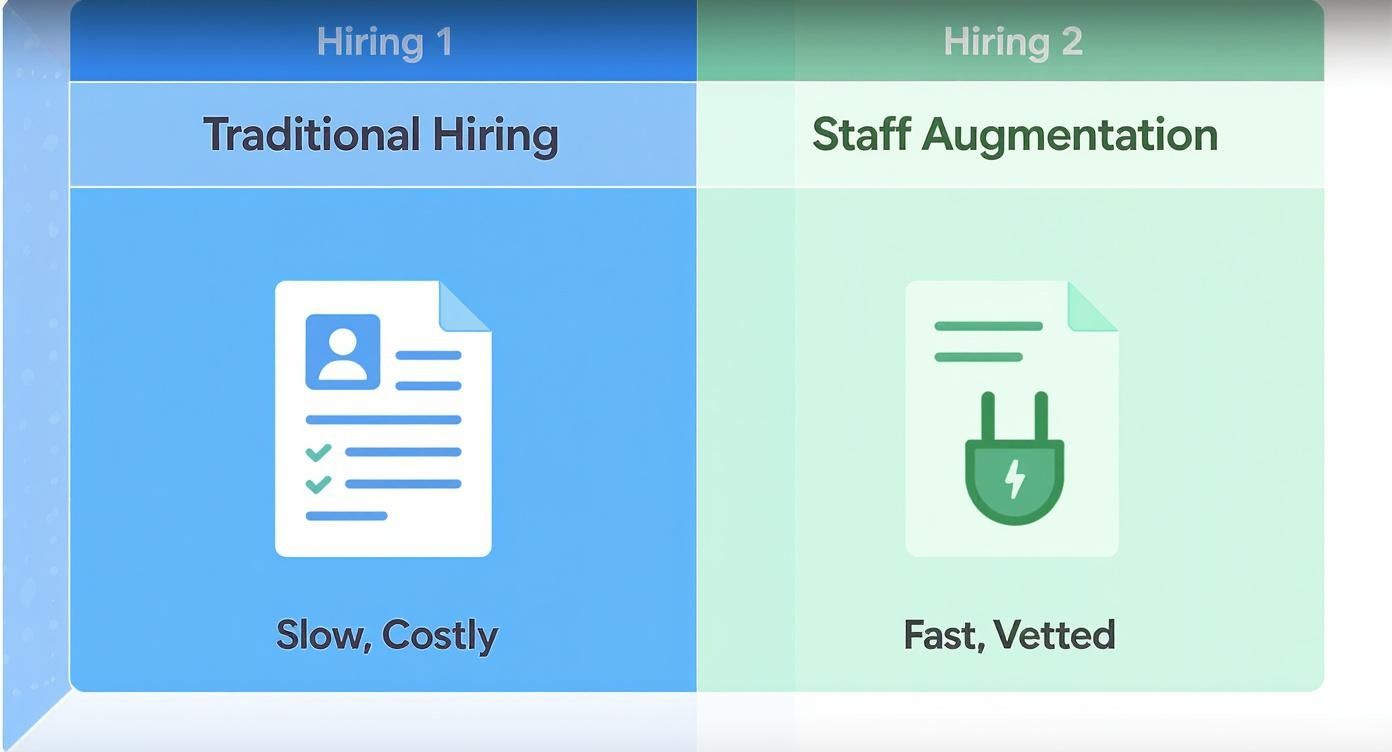
So, what exactly is a staff augmentation company? It’s your on-demand pipeline to pre-vetted, senior-level talent who plug directly into your team. It’s about surgically adding the exact skills you need, right when you need them, without the HR drama, payroll taxes, or a soul-crushing six-month ramp-up.
Let’s be honest. You’re probably here because traditional hiring is a slow, expensive gamble. You post a job, wade through a sea of resumes, and spend weeks interviewing, only to hire someone who looks great on paper but tanks your sprint velocity. The alternative? Paying outrageous recruiter fees that could fund your entire marketing budget for a quarter.
Turns out there’s more than one way to hire elite engineers without mortgaging the office ping-pong table. This isn't about outsourcing your entire department to a faceless firm across the globe. It's about gaining a strategic advantage by integrating top-tier professionals who feel like part of your crew from day one.
A bad hire isn't just a salary down the drain; it's a productivity black hole. It’s the senior engineer you have to pull off a critical feature to babysit the new person. It's the deadlines that get pushed, the code that needs refactoring, and the team morale that takes a nosedive.
The U.S. Department of Labor estimates the cost of a bad hire can reach up to 30% of their first-year earnings. Ouch. This revolving door of hiring, firing, and re-hiring is a massive resource drain. If you want a deeper look into the numbers, we've broken down exactly how the revolving door of hiring is costing you a fortune.
A quality staff augmentation partner flips this broken model on its head. Instead of you spending weeks filtering candidates, they do the heavy lifting. They’ve already vetted thousands of professionals for technical prowess, communication skills, and reliability. This means you get a shortlist of qualified people who are ready to contribute immediately.
To see just how different the two approaches are, let's put them side-by-side.
| Factor | Traditional In-House Hiring | Staff Augmentation |
|---|---|---|
| Time to Hire | 45-90 days (if you're lucky) | 1-2 weeks |
| Recruitment Costs | 20-30% of annual salary | Minimal to none |
| Onboarding | Full HR process, benefits setup | Streamlined integration |
| Risk | High (costly to undo a bad hire) | Low (easy to replace a poor fit) |
The numbers speak for themselves. One path is slow, risky, and expensive. The other is fast, flexible, and efficient.
The goal isn't just to fill a seat. It's to add a force multiplier to your team. Staff augmentation lets you do that with precision, speed, and a fraction of the risk.
Think of it this way: you need a specific type of fuel for your rocket ship. You wouldn't build an entire oil refinery to get it; you'd go to a trusted supplier who has exactly what you need, ready to go. A staff augmentation company is that supplier for your most valuable resource—talent.
Not all staff augmentation partners are created equal. Picking the wrong model is like ordering a steak and getting tofu—it might technically fill a spot, but it’s fundamentally wrong for your needs. You have to know what you’re walking into before you sign a contract that leaves you babysitting glorified freelancers.
The market is exploding right now. In fact, the global IT staff augmentation space was valued at around $383.5 billion and is expected to nearly triple in the next decade. That kind of growth means a lot of players are jumping in, and not all of them are top-tier.
This rapid expansion gives you options, which is both a blessing and a curse. It’s good because competition can drive quality; it's bad because it’s easy to get lost in the noise. Let’s cut through it.
Generally, you'll run into three types of companies. Understanding them is the first step to avoiding a very expensive, time-consuming mistake.
The "Body Shop"
These are the volume players. They have a massive database of resumes and can send you a dozen candidates before you finish your morning coffee. The problem? Their vetting is often paper-thin. Hope you enjoy spending your afternoons fact-checking resumes and running technical interviews—because that’s your full-time job now. They get you a body in a seat, but the quality is a total crapshoot.
The Boutique Specialist
On the other end of the spectrum, you have the niche specialists. They focus on one specific area, like blockchain development or cybersecurity. They're fantastic for finding that one "unicorn" developer who knows a rare framework inside and out. The trade-off is a tiny talent pool and eye-watering costs. Great if you have deep pockets and a highly specific need, but not practical for scaling an entire team.
The Managed Talent Platform
This is the modern approach. These companies (and yes, this is where we fit, toot, toot!) use technology for rigorous, multi-stage vetting but also handle the entire administrative side of things. Think of it as talent-as-a-service. They don’t just find you an engineer; they manage their payroll, benefits, and local compliance, freeing you up to focus on what matters: building your product. It’s the sweet spot between volume and specialization, delivering elite talent without the operational headache.
To see the difference, here’s a simple comparison between the old way and the new, smarter way of hiring.

The key insight here is the shift from a slow, costly process to a fast, pre-vetted one. It fundamentally changes how you acquire the critical skills your team needs to win.
The right choice comes down to your project's needs and your tolerance for risk and administrative overhead. Are you just trying to fill a seat with anyone who can write code? A body shop might work in a pinch. Do you need the world’s foremost expert in quantum computing? A boutique firm is your best bet.
But if you need to build a high-performing, scalable team without becoming an international HR expert overnight, a managed talent platform is the most pragmatic choice. They blend the speed of a large network with the quality of a specialist. It’s important to distinguish this from other hiring models, which you can explore in our guide on staff augmentation vs. consulting.
Your goal isn't just to hire someone; it's to accelerate your roadmap. The right staff augmentation company acts as a true partner, not just a resume factory.
Ultimately, making a smart decision means asking the right questions about vetting, integration, and ongoing support. For more perspectives on talent solutions and industry trends, resources like Parakeet AI's blog can offer some great insights. Your time is your most valuable asset—don't waste it on the wrong model.
Choosing a staff augmentation company is a lot like picking a co-founder for a high-stakes venture. A bad choice doesn't just slow you down—it creates a world of pain, missed deadlines, and demoralized teams. You need to look past the slick marketing slides and the promises of "world-class talent" and focus on what actually moves the needle.
Forget the fluff. A true talent partner isn't just a resume factory. They’re a strategic asset. If you can't tell the difference, you're setting yourself up for a very expensive, very frustrating lesson in mediocrity.
Let's start with the most critical piece of the puzzle: their vetting process. This is the single biggest differentiator between a professional firm and a glorified resume-forwarding service. Don't be shy here. Ask for a step-by-step walkthrough of how they qualify a candidate.
If their answer is vague—something like "we have a proprietary multi-point inspection"—run. A top-tier partner will gladly detail their gauntlet. They should be talking about:
A weak vetting process means you become the vetting process. And you don't have time for that.
Speed is your competitive advantage. When you have a critical gap on your team, you can't afford to wait two months for a traditional hire to materialize. The whole point of engaging a staff augmentation company is to accelerate your roadmap, not put it on hold.
Ask them directly: "How fast can you present me with a shortlist of qualified, vetted candidates?" The answer shouldn't be "it depends."
A great partner should have pre-vetted talent in their network ready to go. The answer should be in days, not weeks. If they have to start their search from scratch the moment you call, they’re just a slow, expensive recruitment agency in disguise.
This speed isn't about cutting corners; it's a direct reflection of the quality of their talent pool and the efficiency of their process.
This is where many firms drop the ball. They find you a developer, make the introduction, and then vanish, leaving you to handle the rest. That’s not a partnership; that’s a transaction.
A true talent partner sticks around. They should be actively involved in making the engagement a success. This means providing real support for:
Without this support structure, you’re just managing another remote contractor with all the associated headaches. With it, you’re adding a fully integrated team member who feels and acts like part of your core crew. To truly identify and partner with an effective staff augmentation company, it's essential to grasp the core desires of hiring managers and what makes a candidate stand out, essentially unlocking the hiring manager's secret wishlist.
Finally, let's talk about the least exciting but most critical part: legal and compliance. Hiring internationally is a minefield of local labor laws, tax regulations, and payroll complexities. One wrong move can lead to hefty fines and legal nightmares.
This is non-negotiable. Your staff augmentation company must handle this for you. They need to be the employer of record, managing all the cross-border HR, payroll, and compliance burdens. If they push any of this responsibility back onto you, they aren't a real partner—they're a liability.

Alright, let's talk about the landmines. You've seen the glossy brochures and heard the sales pitches, but the staff augmentation world is filled with players more interested in your wallet than your product's success. Choosing the wrong partner can set you back months and burn a hole in your budget that’s hard to patch.
Spotting a bad staff augmentation company early is a survival skill. After years on the hiring side of the table, I’ve learned to recognize the warning signs from a mile away. These aren't just minor hiccups; they're giant, waving red flags telling you to turn around and run.
The market is booming. With the IT staff augmentation industry projected to hit roughly $857.2 billion globally, everyone wants a piece of the pie. This explosive growth means a flood of low-quality providers are jumping in. You can discover more about the scale of this market on Verified Market Research. Your best defense is a healthy dose of skepticism.
This is Red Flag #1, and it’s the most common trap. You get a quote for a senior developer that’s less than what you’d pay a junior in-house. It feels like a steal. It’s not.
What you're really getting is a junior developer with an inflated title. They’ll need constant hand-holding, their code will be a mess, and you’ll spend more time managing them than building your product. You'll pay for that "discount" ten times over in shoddy work and missed deadlines.
A truly senior engineer knows their worth. If a company is offering them at bargain-basement prices, it’s because the talent isn't senior, the company is desperate, or both.
When you ask a potential partner about their vetting process, you should get a crisp, confident, step-by-step answer. If you get corporate-speak about their "proprietary talent algorithm" or they dodge questions about where their developers are located, it's a massive red flag.
Transparency is non-negotiable. A legitimate firm will be proud to show you how they operate. Ask them these direct questions:
If their answers are vague, it’s because their process is weak. They’re hiding something, and you don’t have time to play detective. They are likely just a resume mill, not a true talent partner.
This one is infuriatingly common. The company shows you the resume of a rockstar developer—perfect skills, great experience, glowing references. You’re excited and ready to move forward.
Then, just as you’re about to sign the contract, that specific person becomes "suddenly unavailable." But don't worry, they have a "similar" candidate ready for you. This substitute is almost always less experienced and not the caliber you were sold on.
This is a classic sales tactic used by firms with a weak talent pool. They lure you in with a star player they might not even have under contract. Your best defense is to insist on speaking with the exact candidate you’ll be working with before signing anything. If they resist, walk away. It’s a game you don’t want to play.

Here’s a secret the industry won't tell you: staff augmentation often fails because of the client, not the provider. Sorry, but someone had to say it. You can't just 'add a developer' to your Slack channel and expect magic to happen. Success requires a mind-shift on your end.
Dropping a highly skilled engineer into a chaotic environment with no direction is like handing a Formula 1 driver the keys to a car with no steering wheel. It’s a waste of horsepower and a recipe for a crash. The best talent in the world can't succeed if they're set up to fail.
This isn't just a side hustle anymore; global organizations are projected to spend around $81.87 billion on these services. This shift shows that augmentation is becoming a core part of modern talent strategy, not just a temporary patch. You can learn more about this growing trend in talent management on Ardem.com.
This is Failure Point #1, and it's a big one. Augmented staff aren't temporary help you can silo in a corner. They are part of your team, period. If they aren't in your daily stand-ups, your sprint planning, and your virtual coffee chats, you’re doing it wrong.
Isolate them, and you kill any sense of ownership. They'll complete tasks, sure, but they'll never feel invested in your product's success. True integration means treating them exactly like you treat the person sitting (or Zooming) next to you.
Failure Point #2 is a truly terrible onboarding process. Don't just ship them a laptop, send a dozen documentation links, and say, "Go." That’s not onboarding; that’s abandonment. A good staff augmentation company will help, but the responsibility is ultimately yours.
You need a structured, deliberate process that covers:
A great augmented hire can commit code on day one. A poorly onboarded one will spend their first week just trying to get local development set up. The difference is entirely on you.
Finally, we arrive at Failure Point #3: painfully unclear expectations. If you can’t articulate what a "win" looks like for their first 30, 60, and 90 days, how can you possibly expect them to achieve it? Hope is not a strategy.
Your augmented team member is a high-performance engine; it’s your job to provide the roadmap. Define clear goals, establish measurable KPIs, and create a tight feedback loop. For a deeper dive into getting this right, check out our guide on staff augmentation best practices. Don't leave their success to chance.
Alright, let's cut through the noise. When you start digging into the world of staff augmentation, a lot of the same questions pop up. We've heard them all, so let’s get you some straight answers without the marketing fluff.
This one’s simple, but critical. Think of a recruitment agency as a matchmaker. Their job is to find you a candidate, collect their fee (often a huge one), and then wave goodbye. The moment you sign that employment contract, you’re on your own for everything: onboarding, payroll, benefits, local compliance, and retention. Good luck.
A staff augmentation company, on the other hand, is a long-term partner, not a transactional headhunter. They manage the entire administrative and legal lifecycle of the talent. We’re talking payroll, taxes, benefits, and navigating the funhouse of international labor laws.
The developer works as a fully integrated member of your team, reporting directly to your managers, while the partner handles all the backend employment headaches. You manage their work; the partner manages their employment.
This is where the model really shows its value. With a traditional hire, you’re stuck. A bad fit means a painful, legally complicated, and expensive termination process, followed by starting the entire 90-day hiring cycle all over again. It’s a total nightmare.
With a reputable staff augmentation partner, it’s practically a non-issue. You provide direct feedback, and if the person isn't cutting it, the company will quickly and smoothly replace them with a better-suited candidate from their vetted talent pool. This usually happens within days, not months. The risk is almost entirely on the partner to find the right long-term fit, not on you to live with a hiring mistake.
Think of it as a subscription with a satisfaction guarantee. If the service isn't working for you, you get an immediate upgrade, not a three-month cancellation penalty.
Ah, the classic "gotcha." Some less-than-reputable companies love to surprise you with hidden fees. They’ll quote you a low base rate that looks amazing on paper, but then they’ll tack on separate charges for "compliance management," "platform access," "cross-border processing," or some other made-up service. It's the business equivalent of a restaurant charging you for napkins.
A transparent partner will give you one simple, all-inclusive monthly rate per team member. This single number should cover everything: the developer's salary, benefits, payroll taxes, and the company's service fee.
Before you sign anything, ask this question point-blank: "Is this the final, all-inclusive number I will see on my invoice?" If the answer is anything but a confident "yes," you should be very, very wary. No surprises, no excuses. That’s what a real partner provides.